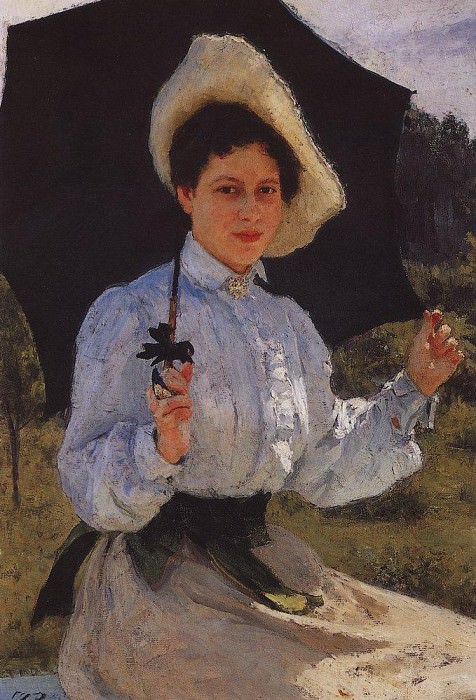In the sun. Portrait of Ilya Repin Ilya Repin (1844-1930)
Ilya Repin – In the sun. Portrait of Ilya Repin
Edit attribution
Download full size: 679×1000 px (0,1 Mb)
Painter: Ilya Repin
1900 marked a second marriage for Ilya Repin. His betrothed was the admiral’s daughter, the writer Natalia Nordman-Severova, in whose name he acquired a mansion in the village of Kuokkala which he called Penates. At the same time an accident happened that was simply fatal for the painter - Repin’s right hand refused to work, so he had to retrain to paint a picture. Note that at this time Repin lived rather secluded, he did not visit his friends and did not participate in exhibitions, despite the fact that the estate of the artist was located in general not far from the capital. Note that Repin was destined to live in the "Pens" until the end of his days.
Description of Ilya Repin’s painting On the Sun
1900 marked a second marriage for Ilya Repin. His betrothed was the admiral’s daughter, the writer Natalia Nordman-Severova, in whose name he acquired a mansion in the village of Kuokkala which he called Penates.
At the same time an accident happened that was simply fatal for the painter - Repin’s right hand refused to work, so he had to retrain to paint a picture. Note that at this time Repin lived rather secluded, he did not visit his friends and did not participate in exhibitions, despite the fact that the estate of the artist was located in general not far from the capital.
Note that Repin was destined to live in the "Pens" until the end of his days. As a result of the turbulent events that followed, Finland seceded from Russia, which had now become Soviet.
The appearance of the portrait of Nadezhda Repina - the daughter of the great artist - also belongs to this period. The tone of the picture is unusually light and peaceful: a girl, walking in the park, decided to take shelter from the heat of the day under an umbrella.
She is dressed in the fashion of the last century: a white blouse, embellished with a brooch, and a skirt with a wide belt. She has a hat on her head. The woman’s face is extremely calm and serene, and this idyll can only be broken by a bumblebee that appears out of nowhere. Note that Repin until the end of his life remained a realist.
Despite the fact that he continued to write at the turn of the century, his work is no example of Impressionist and Symbolist experiments such as "Demon" Vrubel and "Poppies in Arzhantey" by C. Monet. However, this did not prevent Repin to create a psychologically very accurate and "live" paintings. This applies in full measure to the painting "In the Sun.
It seems that a few more moments - and we’ll feel the heat of the afternoon, feel the enticing smell of herbs and flowers, and somewhere nearby we hear the buzzing of the flying bumblebee to us.
Кому понравилось
Пожалуйста, подождите
На эту операцию может потребоваться несколько секунд.
Информация появится в новом окне,
если открытие новых окон не запрещено в настройках вашего браузера.
You need to login
Для работы с коллекциями – пожалуйста, войдите в аккаунт (open in new window).




















COMMENTS: 1 Ответы
Супер картина
You cannot comment Why?
The painting, titled In the Sun. Portrait of Ilya Repin, depicts a woman seated outdoors on a bright, sunny day. She is holding a parasol, which casts a significant shadow over part of the scene. The woman is dressed in a light-colored, ruffled blouse and a long skirt, cinched at the waist with a dark sash. Her hat, also light-colored, is wide-brimmed and angled in a way that further shades her face. Her gaze is directed towards the viewer with a subtle smile. The background consists of a blurred landscape with greenery and what appears to be trees, suggesting a natural, possibly rural setting.
The subtexts in this painting are multifaceted. The title is particularly interesting as it specifies the subject as Ilya Repin, yet the figure depicted is a woman. This suggests the painting might be a portrait of Repins wife, Elena Molchanova, as Repin was known to paint his wife and family. Alternatively, the title could imply that Repin himself is the artist, and this is a portrait set in the sun by him, rather than a portrait of him. Given the convention of artists signing their work, and the presence of a signature in the lower left corner (though obscured in the provided image), we can lean towards the interpretation of Repin as the artist.
The womans attire and the parasol are indicative of a woman of some means from the late 19th or early 20th century, enjoying leisure time. The parasol serves a dual purpose: it protects her from the sun, a symbol of delicacy and refinement, but it also creates a play of light and shadow that adds depth and visual interest to the portrait. Her direct gaze and gentle smile suggest confidence and a certain approachability. The loose brushstrokes and vibrant rendering of light and color contribute to an impressionistic feel, capturing a fleeting moment in time. The sun in the title is not just a condition of the setting but also a thematic element, highlighting the brightness and warmth of the scene, and perhaps symbolizing clarity or a happy disposition.